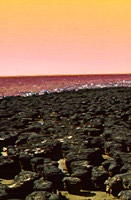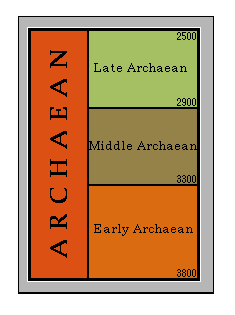
Introduction to the Archaean
3.8 to 2.5 billion years ago
If you were able to travel back to visit the Earth during the Archaean,
you would likely not recognize it is the same planet we inhabit today.
The atmosphere was very different from what we breathe today;
at that time, it was likely a reducing atmosphere
of methane, ammonia, and other gases which would be toxic to most life
on our planet today. Also during this time, the Earth's crust cooled
enough that rocks and continental plates began to form.
It was early in the Archaean that life first appeared on Earth. Our
oldest fossils date to roughly 3.5 billion years ago, and consist of
bacteria microfossils. In fact,
all life during the more than one billion years of the Archaean was
bacterial. At right is an artist's depiction of what an
Archaean coast might have looked like 3.5 billion years ago. The mounds
in the foreground are stromatolites,
colonies of photosynthetic bacteria which have been found as fossils
in Early Archaean rocks of South Africa and Western Australia.
Stromatolites increased in abundance throughout the Archaean, but
began to decline during the Proterozoic. They are not common today.
 |
Subdivisions of the
Archaean:
The chart at left shows the three major subdivisions of the Archaean.
These divisions are somewhat arbitrary, and we have not attempted to
prepare exhibits on each of them. Dates and divisions follow those
of Schopf (1983).
The Archaean occurs between the
Hadean and the
Proterozoic.
|
Read about Tectospheric keels and plate accretion of the Archaean and Proterozoic, as studied by
Paul Stoddard at Northern Illinois University.

Sources:
- Bengtson, S.(ed.) 1994. Early Life on Earth. Nobel Symposium no.84, Columbia Univ. Press, NY, USA.
- Schopf, J. W.(ed.) 1983. Earth's Earliest Biosphere. Princeton Univ. Press, NJ, USA.






